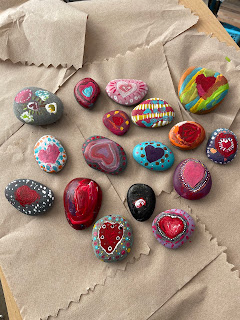The Cavendish Historical Society (CHS) is once again sharing their love of history this February with a “find the heart” hunt at various historical spots in the two villages of Cavendish.
Using the clues below, find the hearts and take a picture and/or add a heart stone of your own to the places that mean the most to you. Please don’t move the rocks.
On March 15, we will remove the heart rocks and place them along the stone wall by the Cavendish Cemetery on High St.
A very special thank you to the CTES 5th/6th grade students who painted the rocks as part of CHS's Young Historians Program.
Cavendish Village Clues
1. All that remains of the tenements built for the Gay Brothers Mill employees is a stone wall. It was in close walking distance of the Mill and is near Pulaski Street (now Pleasant Street) and 131.
2. In the 1950s, the Gay Brothers Mill was sold to F.C. Hyuck and Sons and became “Kenwood Mills.” Along with the Mill, they also acquired the stone building known as the Cavendish Inn. While a former boarding house for workers at the Mill, as well as teachers and others, Hyuck and Sons donated the building to be turned into a health center in 1957. Dr. Eugene (Gene) Bont, along with his wife, nurse practitioner Phyliss, ran the Black River Health Center until 1988.
3. Salmon Dutton subscribed $7,500 (one third money and two thirds labor or materials) for building “Cavendish Academy”-the largest gift received during the fund drive for the school. Dutton, who is credited as the founder of Cavendish Village, was a Universalist and not interested in paying a “preacher tax,” which was customary at the time. Instead he opted to pay for education. It is the fifth oldest academy in the state of Vermont having been incorporated October 26, 1792 at a session of the Vermont Legislature in Rutland. It is also the 24th oldest academy in New England. Over the years, it has served many purposes including being the home of the Cavendish Partnership as well as Perkins Store.
4. The current Mill Street Bridge replaced a covered one back in the early 1900s.
5. With fire and rescue trucks leaving all hours of the day and night, this building was originally built as a home for a newly married couple. Sadly, the wife died before it could be occupied.
Proctorsville Village Clues
1. Built in 1788 as a stage coach stop, this inn is reported to be the most haunted inn in Vermont, if not New England. The innkeepers started a new tradition when they bought the place 13 years ago, the Honey Festival, which takes place in September.
2. What we call the Proctorsville Green, was the vision of a town manager who worked for many years to make it happen. There is a marker in honor of him.
3. This bridge with beautiful planters, once was a covered bridge.
4. Legend has it that just before this cemetery, there used to be what was known as a potter’s field. The lot was destroyed by a party who plowed it up and planted potatoes there during the “Great Depression.” Please note the following: a) CHS has not been able to find any reference to confirm the story of the potato planting, though it is included in the Cemetery Guide developed by Mary Churchill and b) The snow was piled so high at this cemetery, there is no place to put a heart.
5. Built in 1906, the “Adams Opera House” housed a hardware store, library and post office. There was a large hall and well-equipped stage with dressing rooms on the second floor, and another large meeting hall and kitchen on the third floor. Chautauqua lectures and silent movies were part of the entertainment at the Opera House as well as many dramas and musicals. Today it’s the current home of SuperRoasted Coffee. It’s believed to be haunted by the ghost of children.
Answers will be in the Winter CHS newsletter.


No comments:
Post a Comment